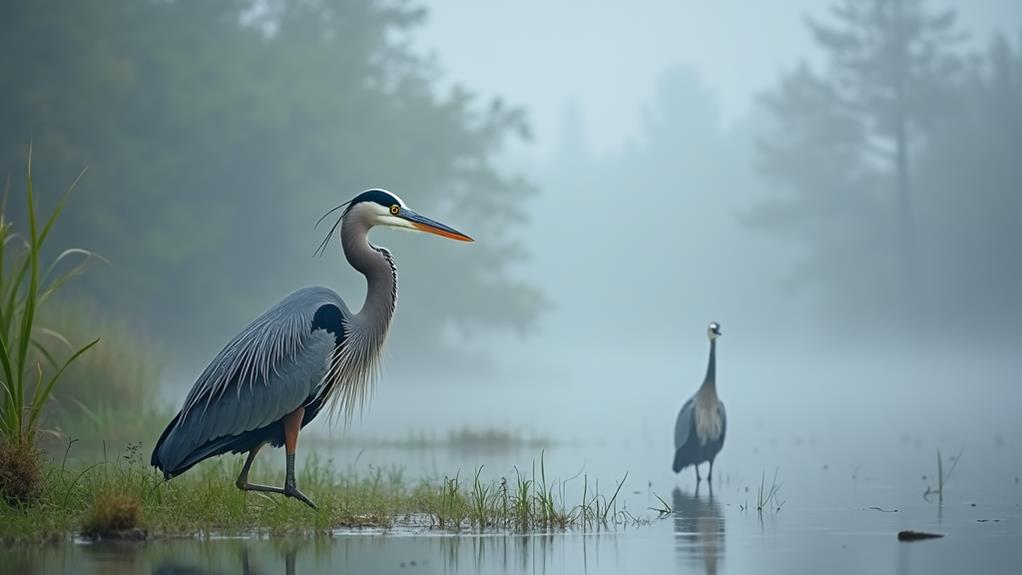As you stand at the water’s edge, a silent sentinel rises from the mist, its feathers a mosaic of blues and whites, its eyes piercing like shards of glass. You’re face to face with different types of Ardeidae, a heron, egret, or bittern, whose very existence seems to defy the ordinary. But it’s not just their striking appearance that sets them apart – their unique adaptations have allowed them to thrive in diverse aquatic environments. From their specialized beaks to their remarkable courtship displays, every aspect of these birds seems tailored to their specific niche. What secrets lie beneath their enigmatic gaze?
Key Takeaways
- Ardeidae family members have unique feather maintenance habits, crucial for insulation, waterproofing, and camouflage, making them expert hunters.
- Their beaks exhibit distinct specializations, such as broad, blunt tips for catching fish and long, pointed tips for probing mud, tailored to specific feeding strategies and habitats.
- Herons, egrets, and bitterns employ a range of hunting and foraging strategies, including visual stalking, ambush tactics, active pursuit, and stealthy approach, adapted to specific prey types and environments.
- They have evolved exceptional camouflage and disguise strategies, using color changes, pattern blending, and vertical stripes to blend in with their surroundings, crucial for survival and reproductive success.
- Unique courtship displays, involving elaborate dance rituals, visual signals, and postures, are crucial for mate selection and reproductive success in these birds.
Distinctive Feathers and Plumage

As you examine the members of the Ardeidae family, you’ll notice their distinctive feathers and plumage, which set them apart from other birds.
One key aspect of their uniqueness is their feather maintenance habits. These birds dedicate significant time to preening, oiling, and rearranging their feathers to maintain their exceptional condition. This fastidious attention to detail is crucial, as their feathers play a critical role in insulation, waterproofing, and camouflage.
The plumage variation within the Ardeidae family is also remarkable.
Herons, egrets, and bitterns display a range of colors, from stark whites to rich, earthy tones. The subtle nuances in their feather patterns and colors allow them to blend seamlessly into their environments, making them expert hunters.
Furthermore, some species exhibit striking crests, plumes, or breeding plumage, which serve as vital visual cues for communication and mating. The intricate details of their feathers and plumage underscore the remarkable adaptability and specialization of these birds.
Beak Shapes and Sizes
You’ll observe that the beaks of Ardeidae species exhibit distinct specializations, such as broad, blunt tips for catching fish and long, pointed tips for probing mud.
Beak length also varies significantly among species, ranging from the 5-centimeter bill of the dwarf bittern to the 15-centimeter bill of the great egret.
As you examine these beaks, you’ll notice that many have tapered tip shapes, which facilitate precise grasping and manipulation of prey.
Beak Specialization Types
Characterizing the beak specialization types of Ardeidae, which comprise herons, egrets, and bitterns, reveals a fascinating array of adaptations.
As you delve into the intricacies of these beaks, you’ll discover remarkable specializations that enable these birds to thrive in their environments.
You’ll notice that each beak type is tailored to specific feeding strategies and habitats.
For instance:
- Tactile foragers have beaks with a high concentration of mechanoreceptors, allowing them to detect prey in murky waters or dense vegetation.
- Visual hunters possess beaks with a more streamlined shape, optimized for swift strikes and accurate targeting of prey.
- Probing specialists have beaks with a unique microstructure, featuring minute sensory pits that aid in the detection of buried or hidden prey.
Beak microstructure analysis and beak sensory adaptations are crucial in understanding these specializations.
By examining the beak’s internal structure and sensory capabilities, you can gain insights into the evolutionary pressures that shaped these remarkable adaptations.
As you explore the beak specialization types of Ardeidae, you’ll appreciate the intricate relationships between form, function, and environment.
Beak Length Variations
Among the Ardeidae, beak length variations are a striking feature, with some species boasting beaks nearly twice as long as their skulls, while others have beaks that are remarkably short and stout.
You’ll notice that beak length ratios vary significantly across species, with some herons having beaks that are up to 1.5 times longer than their skulls, while bitterns have beaks that are roughly equal in length to their skulls.
This size dimorphism is particularly evident when comparing male and female Ardeidae, with males often having longer beaks than females.
Beak length variations are closely tied to feeding adaptations, with longer beaks allowing for more efficient foraging in deeper waters or capturing larger prey.
Conversely, shorter beaks are better suited for snagging fish in dense vegetation or snatching small invertebrates from the water’s surface.
As you explore the diversity of Ardeidae, pay attention to the beak length variations, and you’ll uncover the intricate relationships between beak shape, size, and feeding ecology.
Tapered Tip Shapes
As you examine the beak shapes and sizes of Ardeidae, the variation in tapered tip shapes becomes apparent.
The tapered tip shape is a distinctive feature of herons, egrets, and bitterns, playing a crucial role in their foraging and feeding behaviors.
The tapered tip shape is characterized by its flexibility, allowing for precise manipulation of prey.
This flexibility is made possible by the unique structure of the beak, which is composed of a thin layer of keratin.
The flexibility of the tip also enables the birds to catch and manipulate small prey items, such as fish and insects.
Some key features of tapered tip shapes include:
- Tip flexibility: allowing for precise manipulation of prey
- Feather correlation: the shape of the tapered tip is often correlated with the length and structure of the feathers on the bird’s head
- Prey specialization: the tapered tip shape is often adapted to specific prey types, such as fish or insects, allowing for efficient capture and consumption.
These unique features of tapered tip shapes contribute to the remarkable diversity of foraging strategies and feeding behaviors exhibited by Ardeidae herons, egrets, and bitterns.
Hunting Strategies and Techniques

Perched patiently at the water’s edge, herons, egrets, and bitterns employ a range of hunting strategies and techniques to catch their prey. As you observe these birds, you’ll notice they often use visual stalking, slowly moving towards their quarry while remaining still and alert. This stealthy approach allows them to get close to unsuspecting fish, frogs, or insects before striking with lightning speed.
Other times, they’ll employ ambush tactics, hiding behind vegetation or remaining motionless in the water, waiting for prey to wander into striking distance. Their slender bodies and cryptic plumage help them blend in with their surroundings, making them expert hunters.
Here’s a breakdown of their hunting techniques:
| Technique | Description |
|---|---|
| Visual Stalking | Slowly approaching prey while remaining still and alert |
| Ambush Tactics | Hiding and waiting for prey to come close |
| Active Pursuit | Chasing after prey in a swift and agile manner |
Unique Courtship Displays
During the breeding season, herons, egrets, and bitterns put on a show, exhibiting unique courtship displays to attract mates and strengthen pair bonds.
You’ll witness an array of elaborate dance rituals, showcasing their agility, strength, and grace.
These displays involve a combination of visual signals, vocalizations, and postures that convey information about the individual’s quality, health, and suitability as a mate.
- Upright Posture: Herons, egrets, and bitterns will stand tall, stretching their necks and legs to appear larger and more impressive.
- Feather Manipulation: They’ll adjust their feathers to create an appealing display, such as fluffing out their plumes or raising their crests.
- Rhythmic Movements: They’ll perform synchronized movements, like bobbing their heads or swaying their bodies, to create a sense of harmony and coordination.
Camouflage and Disguise

Stealth is a hallmark of the Ardeidae family, as herons, egrets, and bitterns have evolved exceptional camouflage and disguise strategies to thrive in their environments. You’ll find that these birds have developed remarkable adaptations to blend in with their surroundings, making them expert hunters.
| Species | Camouflage Strategy | Effectiveness |
|---|---|---|
| Herons | Color changes to match water and vegetation | High |
| Egrets | Pattern blending with white and gray feathers | Medium |
| Bitterns | Vertical stripes to mimic reeds and grasses | High |
As you observe these birds, you’ll notice how they exploit their environments to remain inconspicuous. Herons, for instance, can change their feathers’ color to match the water or vegetation they’re standing near. Egrets, on the other hand, rely on their white and gray feathers to blend in with their surroundings. Bitterns take it a step further, using their vertical stripes to mimic the reeds and grasses they inhabit. These camouflage strategies are crucial to their survival, allowing them to sneak up on prey and avoid predators.
Habitat Adaptations and Preferences
You’ll find that herons, egrets, and bitterns exhibit strong affinities for wetland environments, where they’ve adapted to thrive in a variety of aquatic settings.
Many species, in fact, have become specialized to occupy specific coastal regions, exploiting the unique resources these areas provide.
As you explore the habitat adaptations and preferences of Ardeidae, you’ll discover the intricate relationships between these birds and their environments.
Wetland Dwelling Preferences
Ardeidae species, comprising herons, egrets, and bitterns, are intimately tied to wetland ecosystems, where they’ve evolved unique adaptations to thrive in these environments.
You’ll find these birds in freshwater and brackish wetlands, from marshes to swamps, and even in rice fields and aquaculture ponds. Their affinity for wetlands is largely due to the abundance of food sources, such as fish, crustaceans, and amphibians.
In these aquatic zones, you notice that Ardeidae species have adapted to the fluctuating water tables.
They:
- Exploit shallow water areas, where fish and other prey are concentrated.
- Utilize vegetation, such as reeds and cattails, for shelter, nesting, and ambush sites.
- Respond to changes in water levels, moving to areas with optimal water depths for foraging.
Coastal Region Specialization
As coastal specialists, herons, egrets, and bitterns have honed their skills to thrive in marine and estuarine environments, where they exploit the unique characteristics of these ecosystems. You’ll find them masterfully navigating the dynamic intertidal zones, where they’ve developed tidal adaptations to cope with the fluctuating water levels. Their saltwater tolerance allows them to feed on marine prey, taking advantage of the abundant resources in these areas.
| Species | Coastal Adaptations | Habitat Preferences |
|---|---|---|
| Herons | Long legs for wading, sharp vision for spotting prey | Estuaries, mangrove swamps, salt marshes |
| Egrets | White plumage for camouflage, agile flight for pursuit | Open coastlines, sandy beaches, rocky shores |
| Bitterns | Cryptic plumage for concealment, stealthy movements for ambush | Brackish waters, salt pans, coastal wetlands |
| All | Salt-excreting glands, specialized feathers for waterproofing | Marine and estuarine environments |
Migration Patterns and Routes

Many heron species, including the Great Blue Heron, Little Blue Heron, and Great Egret, undertake seasonal migrations between breeding and wintering grounds.
These migrations often span thousands of miles, with some species traveling solo, while others form large flocks.
During the fall migration, you’ll notice herons and egrets following specific routes to reach their wintering grounds.
These routes often take advantage of favorable winds, thermal currents, and food sources.
- Route flexibility: While many heron species follow established migration routes, some individuals may deviate from these paths due to changes in food availability, weather, or habitat destruction.
- Altitudinal migration: Some heron species, like the Great Egret, migrate vertically, moving from higher elevations to lower ones in search of more favorable wintering conditions.
- Spring routes: In the spring, herons often take different routes back to their breeding grounds, which can be influenced by factors such as food availability, weather patterns, and daylight hours.
Understanding these migration patterns and routes is crucial for conservation efforts and habitat protection, ensuring the continued success of these magnificent birds.
Nesting and Breeding Behaviors
After completing their migrations, herons and egrets focus on nesting and breeding, a critical phase in their life cycle.
You’ll observe that they return to their breeding grounds, often in large colonies, to establish territory and attract mates. Herons and egrets exhibit unique nesting habits, with most species constructing elaborate nests from sticks, twigs, and other vegetation.
These structures can be quite complex, with some species building nests that reach several feet in diameter.
Breeding rituals are an essential aspect of heron and egret nesting behavior. You’ll witness males engaging in elaborate courtship displays, which involve intricate postures, vocalizations, and displays of plumage.
These rituals serve to establish dominance, attract females, and strengthen pair bonds. In some species, males will even offer food to potential mates as a form of courtship.
Once paired, herons and egrets will work together to build and maintain their nests, with both sexes taking turns incubating eggs and caring for their young.
Adaptive Feeding Habits

Herons and egrets have evolved remarkable adaptive feeding habits, allowing them to thrive in diverse aquatic environments.
As you observe these birds in their natural habitats, you’ll notice their unique foraging strategies. You’ll see them engaging in aquatic foraging, where they wade in shallow waters, using their long legs and sharp eyesight to catch fish, crustaceans, and other aquatic prey.
They’ll also employ opportunistic scavenging, feeding on carrion and other organic matter they come across.
- Flexibility in diet: Herons and egrets will adjust their diet according to the availability of food sources, making them highly adaptable to different environments.
- Specialized foraging techniques: Each species has developed unique foraging methods, such as the Great Blue Heron’s use of “stand-and-wait” tactics, where it remains still for extended periods, waiting for prey to come within striking distance.
- Efficient energy expenditure: Herons and egrets have optimized their feeding habits to minimize energy expenditure, allowing them to conserve energy for other vital activities, such as breeding and migration.
FAQs:Types of Ardeidae
Can Herons and Egrets Be Domesticated as Pets?
You’ll face significant challenges domesticating herons and egrets as pets, requiring specialized pet training and feather maintenance expertise to ensure their complex social and habitat needs are met, making them unsuitable for most owners.
Do Herons and Egrets Make Good Parents to Their Young?
You’ll find that herons and egrets exhibit diligent parenting styles, with both sexes sharing incubation duties and providing food for their young, showcasing remarkable nesting habits, such as carefully constructed platforms and attentive brooding behaviors.
How Long Do Herons and Egrets Typically Live in the Wild?
You’ll find that herons and egrets typically live between 15 to 25 years in the wild, with wild mortality rates heavily influenced by habitat quality, which affects access to food, shelter, and breeding grounds, ultimately impacting their lifespan.
Are Herons and Egrets Social Birds or Solitary Hunters?
You’ll observe that herons and egrets exhibit both social and solitary behaviors, often displaying flocking behavior during breeding and foraging, yet employing solitary hunting strategies, like stealth and ambush tactics, to catch prey.
Can Herons and Egrets Be Found in Urban or City Environments?
You’ll find that herons and egrets can thrive in urban habitats, adapting to city dwellers’ presence, as they exploit food sources like fish and small rodents in urban wetlands, parks, and even rooftops.
Conclusion
As you delve into the fascinating realm of Ardeidae, you’ll be astonished by the sheer magnitude of their uniqueness. Their feathers are a masterpiece of intricate design, beaks a precision instrument, and hunting strategies a symphony of stealth. Every aspect of their behavior, from courtship displays to habitat adaptations, is a testament to their unparalleled adaptability. It’s as if they’ve perfected the art of survival, outwitting predators and exploiting prey with ease. In this world of avian wonders, the Ardeidae family reigns supreme, a true marvel of evolutionary excellence.













